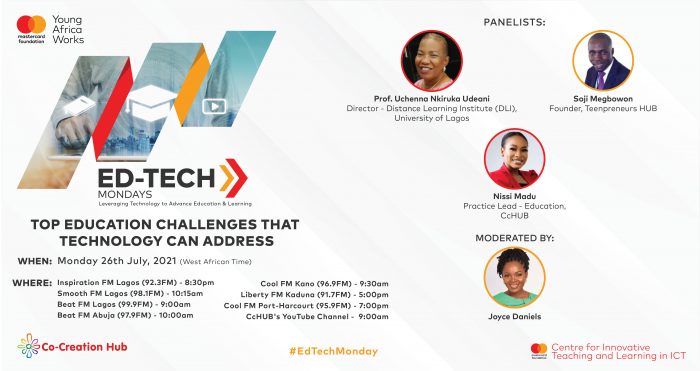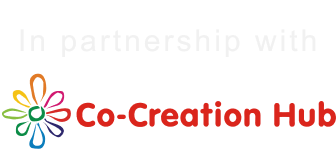In a survey conducted by Co-Creation Hub to 90 respondents on top educational challenges technology can solve, respondents indicated that technology can improve access to teaching and learning aids, curb Examination malpractices, Monitoring of Learners performance, Outdated Curriculums and provide continuous training opportunities for teachers. In this episode, we highlight points from the speakers on how technology can address top educational challenges in Nigeria.

How do you believe technology would address the problem of access to teaching and learning aids in Nigeria?
Technology is evolving to become part of the educational system. This advancement in technology has necessitated the use of digital tools in teaching and learning to enrich learning and support educational systems. With these digital tools it improves teaching and learning and there are a lot of them to be used. Examples are E-resources, which refers to information and learning resources on the web that are available for us to access for teachers and learners. Many collections of these tools and resources are found on the web and we call them information resources. Examples are web portals, world of e-books, e – laboratories, kindle, google books, multiple databases in libraries, and also the UNESCO web portals for teachers, including online encyclopedias for teachers.
Another area that is gaining traction is open educational resources. This has become very useful for education at secondary and tertiary levels. They are all open without restriction for use and it is adapted for teaching and learning. They are easily accessed from the web. When we use technology we have to also be thinking about the infrastructure to use the technology. However with this what we need is digital skills and digital tools and internet connectivity. So technology has enabled us to access a plethora of information in form of teaching and learning aides
How can technology address the challenge of Malpractice in schools?
Malpractice is a challenge that has been ongoing before now in the education sector. It is alarming that at the current stage, parents are mostly still influenced by this act. However, technology is an enabler and there are some organisations that have adopted technology to reduce malpractice such as JAMB. JAMB moved from a paper structured process of examination to a paperless exam process using CBT (Computer Based Test). For example, organisations have also adopted the use of computer-based tests for entry exams. For Jamb, this has drastically reduced malpractices and the influence of malpractices within the educational sector. With tools like Google sheet, Google Docs, Google forms contents and exams can be set and results can be gotten in real-time. It is a system that anyone can use.
How can Technology provide or improve access to continuous training opportunities for teachers?
Teachers are the catalyst to bringing transformation in the educational spaces. However there are challenges that can impede teachers’ continuous training, such as travel time, distance, schedule of teachers, however with access to technology, training can be brought to teachers’ fingertips. During the lockdown last year, re: learn supported teachers training through the use of WhatsApp. Teachers from Zamfara and Sokoto were able to have access to the training, despite their location. All they needed to do was to have a mobile phone and an internet connection and they participated in the training. Also with the use of technology, teachers were able to connect and collaborate across various states or locations in Nigeria. This created a community where teachers can share ideas, collaborate with each other, including real time support for teachers while adopting the learning in their classroom, they are able to seek Real-time support.
The government also has a role to play. For example, during the lockdown, the Lagos state government partnered with Microsoft to train teachers across Lagos state. The training was conducted on over 10,000 teachers in Lagos state. Microsoft also has a community called the Microsoft education community, where teachers can take over a million courses for free.
Is there a role technology plays in supporting school infrastructure?
When we refer to physical infrastructure, technology has solved infrastructural challenges. For example technology, it solves the challenge of teaching in large classrooms. At the University of Lagos, such classes have gone online, which has averted congregating large numbers of students into one class. The COVID-19 also fostered the acceleration of the adoption of such technology for classes online such as Zoom, Google meet, and Google classrooms. Even during exams, technology supported the administration of exams to students, including invigilation and marking of students’ scripts.
Technology has also enabled the use of online libraries and databases, where students can access and read, instead of having to build tall libraries and overcrowded libraries. Also, technology enhances mobile learning, through the use of tablets or mobile phones. At the moment classes are being live-streamed in Unilag through the lecturers’ YouTube channel or the schools’ YouTube channel, therefore there is no need to build large lecture halls.
How can technology address challenges around the assessment and monitoring of learners?
One area where technology can support the assessment of students’ learning is the amount of learning analytics and insights we can get from students’ learning and areas where students are struggling. Depending on how questions are framed and platforms adopted, we are able to identify where students are struggling and focus our intervention on such areas. In that way, it is a lot easier to create a personalised learning for students.
At the University of Lagos, Moodle an e-learning management system is currently adopted to monitor students’ learning. Through Moodle the school is able to assess how students are contributing to discussion forums, quizzes being put online, and if they are submitting their assignments. The Moodle is also used to track students’ activities and identify students who are carrying out the in-class activities or not. Moodle has helped the University of Lagos to provide real-time analysis of students’ performance and also track areas where students are not doing well, in order to provide real-time interventions.
Can technology enhance the speedy revision of the current outdated curriculum used in schools?
When it comes to teaching subjects such as STEM (Science, Technology, Engineering, and Mathematics), digital labs can be adopted to support personalised learning experiences for students. These digital labs have simulations that help students to learn about science concepts that could be very abstract or theoretical. For example in learning about the first law of thermodynamics, many times students cram it and don’t know how exactly it plays out in real life. But with digital labs, it helps students to connect the learning to real-life examples. Co-creation will be starting a project with the Lagos state government in September, where 20 schools will be using these digital labs for teaching and learning -of science concepts, which deepens learning, and -it supports innovative teaching methodologies.
What will it take at the policy level to enable technology across the country to rise and meet these challenges in Education?
The government can implement policy frameworks for the integration of technology into the educational system. Commitment to these frameworks by the government is needed to ensure that they are adhered to and implemented.
Implementation support is also needed such as funds, teacher training, equipment/materials needed to use these in the classroom. However, a more difficult aspect is the adoption of these policies by teachers. This is a challenge because teachers are not carried along during the policy development stage, therefore the ideas and thoughts of teachers are not being implemented, but these teachers are made to implement policies that they were not involved with at the beginning. Therefore teachers must be carried along in the policy formulation and all stakeholders must be brought on board, including students.
The private sector also has a role to play in providing access to devices and internet facilities for students in schools. These public-private partnerships will help drive the adoption of such technologies in schools.




